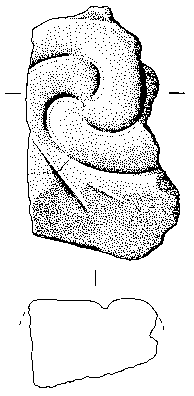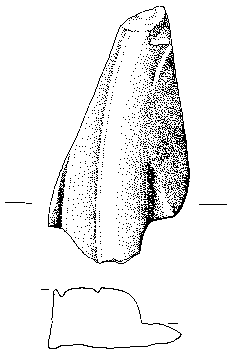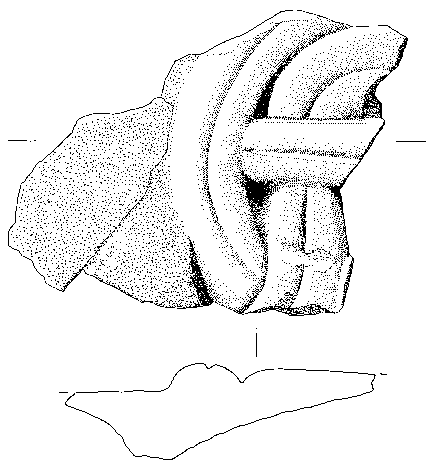 Bulletin
4, 1998
Bulletin
4, 1998
New Finds of Sculpture to April 1999
Martin Carver
The so-called "Calf Stone" (TR28) was discovered in 1997 in what was then thought to be the shallow depression at the top of a post-medieval pit. On excavation in 1998, this depression proved to be caused by the collapse of a stone-lined culvert, of which TR28 had formed part of the cover. Additional evidence for this context was obtained with the discovery of TR35, a slightly smaller fragment of the same fabric carrying similar ornament which had been used as a side-lining for the same culvert. The two pieces joined (Fig 6), and clearly belonged to a larger panel which had been broken up to revet the drain. The drain was not fully excavated in 1998, so additional pieces of the same or contemporary sculpture are anticipated in future seasons.
Figure 6: Fragment of TR35 shown Joined to TR28
TR28 on its own seemed unfinished, in that the stone between the animals' legs had not been flattened to provide a platform for the relief carving, and it was suggested (Bull. 2, 23) that it might have been a trial piece. In the conjoined piece this interpretation looks less convincing. A set of shallow parallel grooves on the upper edge suggests that this was a free-standing illustrated panel, with the rough lower edge set into the ground or a foundation of some kind. The illustration is very busy: two cattle tend a calf; a horse rears (perhaps carrying a rider) in confrontation to a lion-like creature; a fearsome quadruped with hooked beak and clawed hooves menaces a lamb. All the animals have typically Pictish scroll body-marking and the motifs are laid out in equally characteristic "floating composition". That is, they interlock and are not set on ground lines (Isabel Henderson, pers.comm). There is no trace of carving on the back, so the panel may have been hacked off a thicker slab. In this case it may have formed a panel at the bottom of a slab, similar in theme and composition to one on the Shandwick cross-slab (ECMS III, 72). But a role as the side-panel of a shrine or stone coffin is also possible. The importance of this piece has been raised even further by its being the only Tarbat sculpture so far found to be certainly carved in local stone (see Nigel Ruckley's report).
Three fragments of stone carved in relief have been recovered from other contexts in the Glebe Field excavation, all relating to the charcoal layer mentioned above (fig 7). They are very fresh, suggesting that they come from a monument that was indoors or fairly new when destroyed and buried. One, TR36, is a fragment of spiral ornament such as may be seen on the Shandwick slab (ECMS III, 72, lower) and elsewhere in the Tarbat corpus ( TR2, 23; Bull 3, appendix 2). The other two are carved in high relief with a smooth finish and may have been part of a cross-shaft. TR37 is apparently the curved edge of a shaft or wheel-head. TR38 is a piece of double-strand interlace, parallels for which can be found at Bressay, Shetland (ECMS III,7) and nearer home at the possible monastic site of Kinnedar 10 (Drainie, near Elgin, ECMS III, 147). Of Kinneddar 10 Allen notes that the interlace pattern (his no. 576) has parallels in Durham Cathedral. This might imply a manufacture and destruction date as late as the 11th century, a date not incompatible with the turbulent historic times exemplified by the Battle of Tarbat Ness of about 1035.
 TR 36 |
 TR 37 |
|
 TR 38 |
||
Figure 7: Fragments of sculpture from the glebe Field Excavations
NEXT: Stone for Carving
BACK: Site and Settlements
Last updated 10 October, 2003.
Contact the Tarbat Discovery Programme



